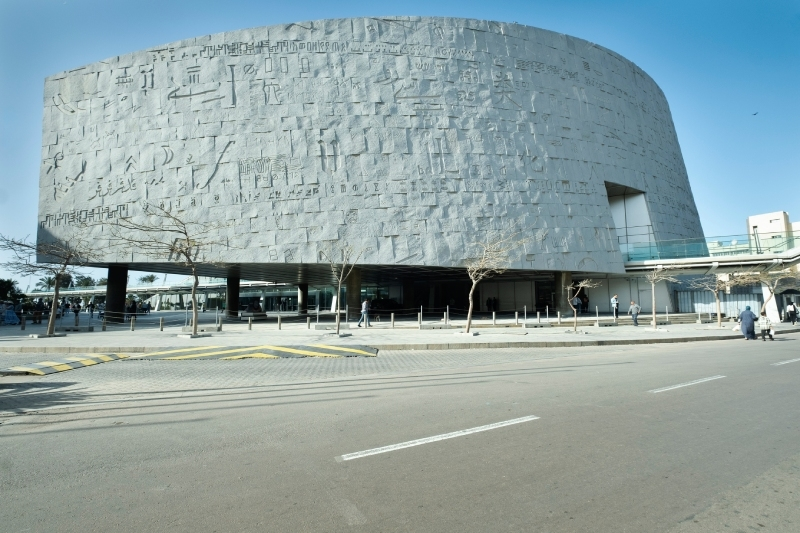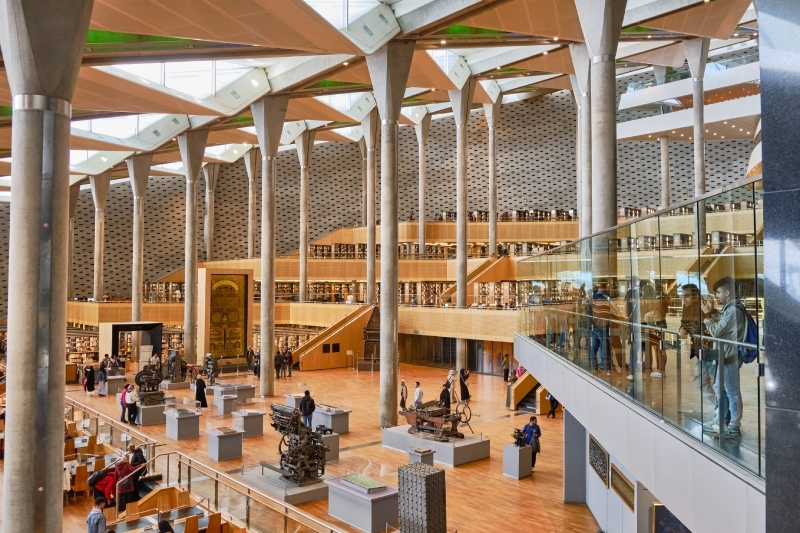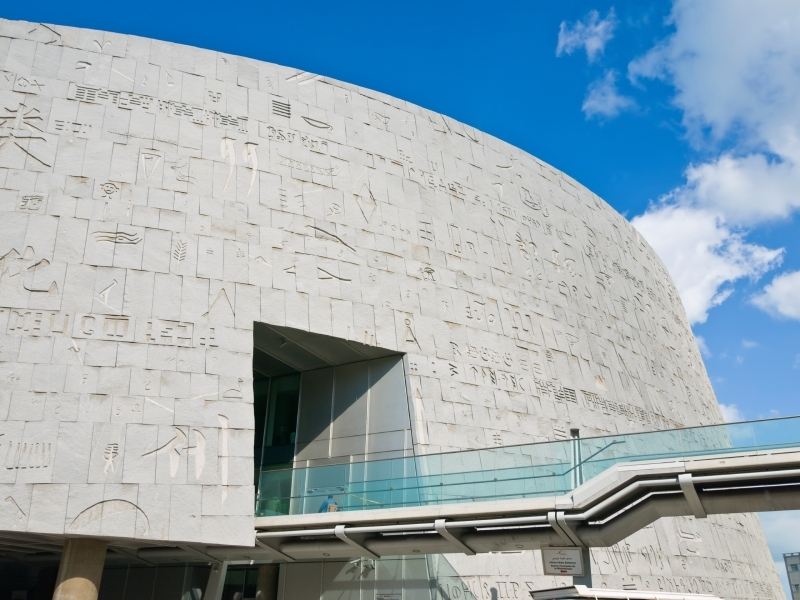Alexandria Library Egypt | Bibliotheca Alexandria

Introduction: A Beacon of Knowledge in the Ancient World
The Library of Alexandria has fascinated historians, travelers, and dreamers for centuries. Once hailed as the greatest center of learning in the ancient world, it stood as a beacon of knowledge that drew the brightest minds from across the Mediterranean. Established in the 3rd century BCE under the Ptolemaic dynasty, it carried an audacious mission: to collect, preserve, and expand upon all human knowledge. At its height, the library is said to have housed anywhere from 200,000 to 700,000 scrolls, with some estimates reaching nearly a million. Within its walls, science, philosophy, literature, and medicine flourished, reshaping the intellectual landscape of antiquity.
Scholars such as Euclid, Eratosthenes, Aristarchus of Samos, and Zenodotus of Ephesus produced groundbreaking works in mathematics, astronomy, geography, and literature. It was here that Aristarchus first proposed a heliocentric universe, centuries before Copernicus, and where Eratosthenes measured Earth’s circumference with remarkable precision. The library wasn’t just a storehouse of scrolls; it was a living hub of research and discovery, part of the greater Mouseion, an institution that functioned much like a modern university.
Though the ancient library ultimately fell victim to centuries of decline, its vision never truly vanished. Its legacy lives on in the Bibliotheca Alexandrina, a modern marvel inaugurated in 2002 with space for eight million books, expansive digital archives, and cultural centers that continue Alexandria’s role as a global hub of knowledge. The story of the Library of Alexandria is one of ambition, brilliance, tragedy, and revival—a story that continues to inspire both scholars and travelers, often featured in cultural itineraries and Egypt tours.
Origins of the Library of Alexandria
A Bold Vision of Universal Knowledge
The Library of Alexandria was born from a revolutionary idea: to collect every book ever written. Demetrius of Phalerum, a student of Aristotle or Theophrastus, is often credited with inspiring the project. Ships docking at Alexandria were compelled to surrender their manuscripts for copying, and Ptolemaic agents scoured the Mediterranean for rare works. This aggressive approach transformed the library into the largest and most ambitious collection of texts the ancient world had ever seen.
Royal Patronage and Scholarly Support
The library’s success was fueled by the Ptolemaic dynasty, particularly Ptolemy I Soter and his successors, Ptolemy II Philadelphus and Ptolemy III Euergetes. Scholars received royal patronage, generous stipends, free lodging, and exemption from taxes. Freed from material concerns, they could dedicate themselves entirely to research, teaching, and writing.
The Mouseion – An Ancient Research University
The library formed part of the Mouseion (Temple of the Muses), an institution that resembled a modern research university. It featured lecture halls, reading rooms, botanical gardens, observatories, and even laboratories. This dynamic environment fostered collaboration across disciplines, making Alexandria the intellectual capital of the ancient Mediterranean.

What Made the Library of Alexandria Unique
Universal Ambitions and Aggressive Collecting
Unlike other ancient libraries, the Library of Alexandria wasn’t content to preserve local traditions—it aimed for universality. Multiple versions of Homer’s epics were collected from different regions, while texts in Egyptian, Mesopotamian, Indian, and Persian traditions were translated into Greek. By the 3rd century BCE, estimates suggest the collection had surpassed 200,000 works, later swelling to as many as 500,000 scrolls covering history, science, law, philosophy, medicine, and literature.
Pioneers of Organization and Criticism
Zenodotus of Ephesus, the library’s first head librarian, introduced alphabetical order as a system of classification. Callimachus created the Pinakes, a 120-volume catalog considered the world’s first comprehensive library catalog. Aristarchus of Samothrace, another eminent head librarian, produced definitive editions of Homer with detailed commentary. These innovations established the foundations of modern librarianship.
The Scholars Behind the Knowledge
Mathematical and Scientific Breakthroughs
- Euclid authored Elements, still considered the cornerstone of geometry.
- Eratosthenes not only calculated Earth’s circumference but also devised the first system of latitude and longitude.
- Aristarchus of Samos suggested a heliocentric solar system nearly 2,000 years before it gained acceptance.
- Herophilus and Erasistratus advanced medicine through anatomical dissections, work unmatched until the Renaissance.
Literary Contributions
- Zenodotus standardized Homer’s works.
- Callimachus organized Greek literature systematically.
- Aristophanes of Byzantium compiled the first Greek dictionary.
- Dionysus Thrax produced the first grammar rulebook, used in schools for centuries.
This intellectual melting pot transformed Alexandria into the greatest academic hub of the ancient world.

The Fall of the Library of Alexandria
A Story of Gradual Decline
The common image of a single catastrophic blaze is more myth than reality. Instead, the Library of Alexandria suffered a slow decline over centuries.
Incidents of Damage
-
48 BCE: Julius Caesar’s siege of Alexandria caused fires that damaged scrolls stored near the docks.
-
3rd century CE: Emperor Aurelian’s campaign ravaged parts of the city, including the palace quarter.
-
4th century CE: Religious upheaval under Theophilus saw pagan temples destroyed, possibly affecting what remained of the library.
-
297 CE: Diocletian’s siege inflicted further destruction.
Loss of Patronage
The decline began even earlier, in 145 BCE, when Ptolemy VIII exiled scholars, including Aristarchus of Samothrace. Without patronage, resources dwindled, and maintaining fragile papyrus scrolls became increasingly difficult.
Myths of Final Destruction
The tale of Caliph Omar burning the library in 642 CE has long been repeated but is now considered a later fabrication, first appearing centuries after the alleged event. Modern historians reject it as myth.

Customize Your Dream Vacation!
Get in touch with our local experts for an unforgettable journey.
Plan Your Trip
From Ruins to Revival – The Bibliotheca Alexandrina
A Modern Rebirth of Ancient Wisdom
In 2002, the spirit of the ancient library was reborn as the Bibliotheca Alexandrina. Costing $220 million, this project represented a partnership between the Egyptian government, UNESCO, and international collaborators.
Architectural and Cultural Marvel
Designed by Norwegian firm Snøhetta, the building features a striking circular form with a glass-paneled roof tilted toward the Mediterranean, symbolizing a sundial of knowledge. The library can house up to eight million books across seven cascading levels.
Facilities and Digital Innovation
- A rare books collection and specialized libraries, including one for the visually impaired.
- Museums, art galleries, and a planetarium, blending culture with science.
- The Digital Assets Repository (DAR), storing vast archives in collaboration with the Internet Archive, preserving over 1.5 petabytes of data.
Global Impact
The modern library hosts more than 1,500 cultural and academic events annually and welcomes nearly a million visitors each year. With centers dedicated to manuscripts, Mediterranean studies, and Coptic heritage, the Bibliotheca Alexandrina reclaims Alexandria’s place as a beacon of global learning.
Conclusion: A Legacy That Lives On
The Library of Alexandria was never just a building; it was a bold vision to collect, preserve, and expand the world’s knowledge. With the backing of the Ptolemaic rulers and the brilliance of scholars like Euclid, Eratosthenes, and Callimachus, it became the ancient world’s greatest intellectual hub. Although centuries of political turmoil, fires, and neglect led to its decline, its legacy endures through the Bibliotheca Alexandrina, where ancient ambition meets modern innovation. Today, the library continues to inspire curiosity, bridging past and future as a true testament to the human spirit of discovery.
Experience the Library of Alexandria on unforgettable Egypt tours. Learn, explore, and immerse yourself in ancient wonders today.
The Library of Alexandria was the most famous library of the ancient world, established in the 3rd century BCE in Alexandria, Egypt. It aimed to collect all the world’s knowledge in one place.
The library was established under the rule of Ptolemy II Philadelphus, building upon the vision of his father, Ptolemy I Soter, one of Alexander the Great’s generals.
Estimates vary widely, ranging from 200,000 to 700,000 scrolls, covering science, literature, medicine, philosophy, and more.
It aimed to collect every known work in existence, benefiting from Ptolemaic patronage and functioning as part of the Mouseion, an early research university.
Estimates range from 200,000 to 700,000 scrolls, though some ancient accounts claim even more.
Opened in 2002, it is a modern tribute to the ancient library. With room for eight million books, advanced digital archives, and multiple museums, it continues Alexandria’s legacy as a hub of global knowledge.
It was created to revive the spirit of the ancient library and restore Alexandria’s role as a global hub of learning, culture, and research.
The library has space for 8 million books and houses extensive digital archives, rare manuscripts, and specialized research centers.

























